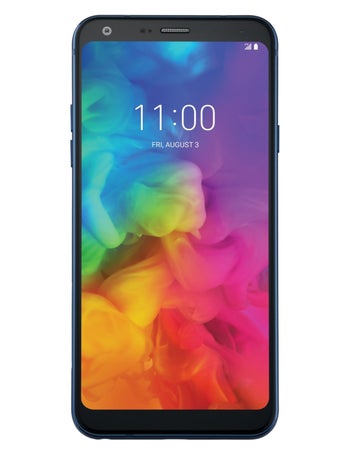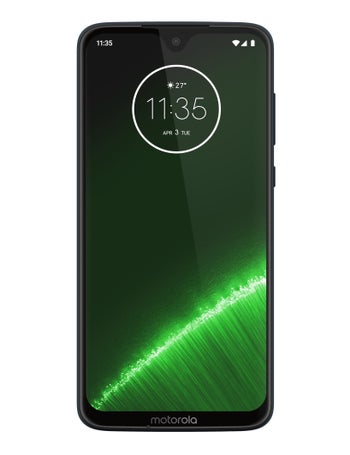LG Q7+ vs Motorola Moto G7 Plus Specs Comparison
Compare mobile phone specifications of up to three devices at once. Our specs comparison tool helps you find and compare the perfect phone for your needs.
|
|
|
| LG Q7+ | Motorola Moto G7 Plus |
|
Released
·
Aug 03, 2018
|
Released
·
Feb 07, 2019
|
|
5.5-inch · 2160x1080px
|
6.2-inch · 2270x1080px
|
|
Single camera
|
Dual camera
|
|
4GB · 64GB
|
4GB · 64GB
|
|
3000 mAh
|
3000 mAh
|
| Check Accessories | Check Accessories |
Availability
| Officially announced | |
|---|---|
| May 21, 2018 | Feb 07, 2019 |
Design
| Dimensions | |
|---|---|
| 5.66 x 2.73 x 0.33 inches 143.8 x 69.3 x 8.4 mm |
6.18 x 2.96 x 0.33 inches 157 x 75.3 x 8.3 mm |
| Weight | |
| 5.11 oz / 145.0 g | 6.21 oz / 176.0 g |
| Materials | |
| Back: Glass (Corning Gorilla Glass) Frame: Aluminum |
|
| Resistance | |
| Water, Dust; IP68; MIL-STD-810 certified | Splash |
| Biometrics | |
| 2D Face unlock, Fingerprint (touch) | 2D Face unlock, Fingerprint (touch) |
| Features | |
| Notification light | |
| Keys | |
| Left: Volume control; Right: Lock/Unlock key | Right: Volume control, Lock/Unlock key |
| Colors | |
| Blue | Blue, Red |
Display
| Size | |
|---|---|
| 5.5-inch, 78.31% screen-to-body | 6.2-inch, 81.52% screen-to-body |
| Type | |
| IPS LCD | IPS LCD |
| Resolution | |
| 2160x1080px, 18:9 ratio, 439 PPI | 2270x1080px, 19:9 ratio, 405 PPI |
| Protection | |
| Corning Gorilla Glass 3 | |
PhoneArena Display Test
| Bright Max (20% APL) | |
|---|---|
| Untested | Untested |
| Bright Min | |
| Untested | 2 (Good) |
Learn more on our
PhoneArena Display Test Results page.
Hardware
| System chip | |
|---|---|
| Snapdragon 450 SDM450 (14 nm) | Snapdragon 636 SDM636 (14 nm) |
| Processor | |
| Octa-core 1800 MHz ARM Cortex-A53 |
Octa-core 1800 MHz Kryo 260 |
| GPU | |
| Adreno 506 | Adreno 509 |
| Memory | |
| 4GB (LPDDR3)/64GB | 4GB (LPDDR4)/64GB |
| Storage expansion | |
| microSDXC up to 2000 GB | microSDXC up to 512 GB |
| OS | |
| Android (9.0 Pie, 8.1 Oreo) | Android (10, 9.0 Pie) |
Battery
| Type | |
|---|---|
| 3000 mAh, Li - Ion | 3000 mAh |
| Charging | |
| MediaTek Pump Express | Qualcomm Quick Charge 4, USB Power Delivery, Motorola TurboPowe |
Camera
| Rear | |
|---|---|
| Single camera | Dual camera |
| Main camera | |
| 16 MP (PDAF) Aperture size: F2.2 Sensor size: 1/3" Pixel size: 1.12 μm |
16 MP (OIS, PDAF) Aperture size: F1.7 Focal length: 27 mm Sensor size: 1/2.6" Pixel size: 1.22 μm |
| Second camera | |
| 5 MP (Depth information) Aperture size: F2.2 |
|
| Flash | |
| LED | Dual LED |
| Video recording | |
| 1080p (30 fps) Picture-taking during video recording, Video light, Video calling, Video sharing | 4K UHD (30 fps), 1080p (120 fps), 720p (240 fps) Time-lapse video, Hyperlapse, EIS, Video calling, Video sharing |
| Front | |
| 8 MP (HDR) Video capture: 1080p |
12 MP (HDR) Video capture: 4K UHD (30 fps) |
Connectivity & Features
| Bluetooth | |
|---|---|
| 4.2 | 5.0 |
| WLAN | |
| a,b,g,n,ac,dual-band Wi-Fi Direct, Hotspot 802.11 b, g, n | a,b,g,n,ac,dual-band Wi-Fi Direct, Hotspot 802.11 a, b, g, n, ac |
| USB | |
| Type-C, USB 2.0 | Type-C, USB 2.0 |
| Sensors | |
| Accelerometer, Gyroscope, Compass, Ambient light sensor, Proximity sensor | Accelerometer, Gyroscope, Compass, Ambient light sensor, Proximity sensor |
| Hearing aid compatible | |
| M4/T3 | |
| Location | |
| GPS, A-GPS | GPS, A-GPS, Glonass, Galileo, Cell ID, Wi-Fi positioning |
| Other | |
| NFC, UMA (Wi-Fi Calling), VoIP, Tethering, Computer sync, OTA sync | NFC |
Multimedia
| Headphones | |
|---|---|
| 3.5mm jack | 3.5mm jack |
| Speakers | |
| Earpiece, Loudspeaker | Earpiece, Multiple speakers |
| Features | |
| Album art cover, Background playback | Dolby Mobile |
| Screen mirroring | |
| DLNA,Wireless screen share | Wireless screen share |
| Radio | |
| FM | FM |
| Additional microphone(s) | |
| Noise cancellation | Noise cancellation |
Cellular
| LTE Bands | |
|---|---|
| 1, 2, 3, 4, 5, 7, 12, 13, 20, 66, 71 | 1, 2, 3, 4, 5, 7, 8, 18, 19, 20, 26, 28 |
| TDD Bands | |
| 38, 41 | 38, 40, 41 |
| 3G Bands | |
| 5, 4, 2, 1 | 6, 5, 8, 4, 2, 1 |
| Data Speed | |
| LTE-A Cat 6 (300/50 Mbit/s), HSDPA+ (4G) 42.2 Mbit/s, HSUPA 5.76 Mbit/s, UMTS | LTE-A Cat 13/5 (400/75 Mbit/s), HSDPA+ (4G) 42.2 Mbit/s, HSUPA 5.76 Mbit/s, UMTS |
| SIM type | |
| Nano SIM | Nano SIM |
| HD Voice | |
| Yes | |
| VoLTE | |
| Yes | |
Regulatory Approval
| FCC approval | |
|---|---|
| Date approved: Sep 24, 2018 FCC ID value: ZNFQ610TA | |
| Measured SAR | |
| Head: 0.36 W/kg Body: 1.10 W/kg Simultaneous Transmission: 1.46 W/kg Wireless Router: 1.30 W/kg |
|
Alternative variants
International version
| System chip | MediaTek MT6750S (28 nm) |
|---|---|
| Processor |
Octa-core 1500 MHz ARM Cortex-A53 |
| GPU | Mali-T860 MP2 |
| WLAN | b,g,n |
Dual SIM
| Dual SIM | Yes |
|---|---|
Discover more
|
|


